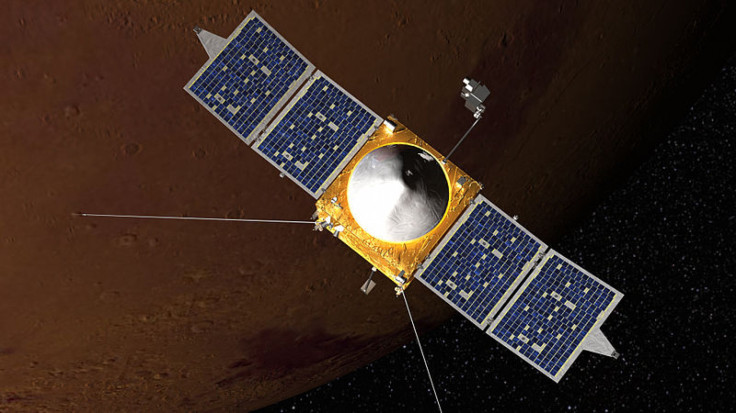MAVEN Mars Orbiter's Scientific Toolbox: How The NASA Craft Will Try And Unlock A Martian Past

Mars, which already has two little moons, will be getting a new neighbor in about 10 months. NASA’s MAVEN spacecraft (the Mars Atmosphere and Volatile Evolution Mission) blasted off from Earth on Monday and will be trekking through 400 million miles of space before it reaches its Martian target next September.
MAVEN is no dainty little satellite. It’s the size of a schoolbus, and weighs more than 5,400 pounds (as much as a full-size, fully loaded SUV). It will be joining three other spacecraft currently orbiting Mars: NASA’s Mars Odyssey and Mars Reconnaissance Orbiter, and the European Space Agency’s Mars Express. The newest kid on the block is also going to have the shiniest toys.
Odyssey carries just three primary instruments: a thermal imager, a gamma ray spectrometer used to look at the elements in Martian surface geology, and a radiation experiment (now defunct, likely thanks to, of all things, radiation). This orbiter (along with the MRO) also plays an important role in relaying communications from Mars rovers back to Earth.
The MRO is even more tricked out, with three cameras, radar and two spectrometers. MRO’s most powerful camera is HiRISE, which can snap photos from 300 kilometers above with a resolution down to about a foot (for comparison, the satellite photos on Google Maps have a resolution of about three feet). The orbiter also carries an instrument that can measure perturbations in Mars’s gravitational field.
Mars Express, meanwhile, carries three spectrometers to analyze geological minerals and elements, as well as take observations of the Red Planet’s atmospheric temperature and pressure. It also carries a radar altimeter that can use radio signals to look for frozen water beneath the Martian surface, a radio experiment, a camera, a communications relay, and a device called ASPERA that analyzes the interactions between the upper Martian atmosphere and the solar wind.
MAVEN’s scientific toolkit is even more up-to-date. Six of MAVEN’s instruments are part of a “Particles and Fields package.” This includes a device called the Solar Energetic Particle (SEP), which like ASPERA looks at the interactions between energetic ions of helium and hydrogen emitted by the sun and the upper Martian atmosphere. Another device called the Solar Wind Ion Analyzer (SWIA) is a kind of space weathervane, detecting the density, temperature and velocity of the ions that make up the solar wind rushing by the Red Planet. The SupraThermal and Thermal Ion Composition device (STATIC), meanwhile, keeps an eye on the ions in the atmosphere that get carried away from the planet by the solar wind. The Langmuir Probe and Waves (LPW) takes the measure of extreme ultraviolet light coming from the sun, which helps scientists figure out how quickly Mars loses bits of its atmosphere thanks to energy from the sun. The Solar Wind Electron Analyzer (SWEA) examines the subatomic electron particles in the solar wind and the upper Martian atmosphere, which helps researchers map solar wind regions. And two magnetic sensors mounted on the tips of the craft’s solar panels help the other instruments stay grounded (so to speak), since magnetic fields can affect a lot of the activity in the upper atmosphere.
The new orbiter also carries a spectrometer (NGIMS) that will look at how Martian weather – both dust storms in the atmosphere, and space weather events – influences the escape of atmospheric gas from Mars. NGIMS can also look at the ratio of various elemental isotopes, or variants, in the atmosphere. An ultraviolet light spectrograph (IUVS) will use ultraviolet light to look at the abundance of carbon dioxide in the lower atmosphere of Mars.
With all of these tools, MAVEN will be trying to figure out what forces transformed what we think was once a formerly wet world into the crimson desert planet we know now.
© Copyright IBTimes 2024. All rights reserved.





















